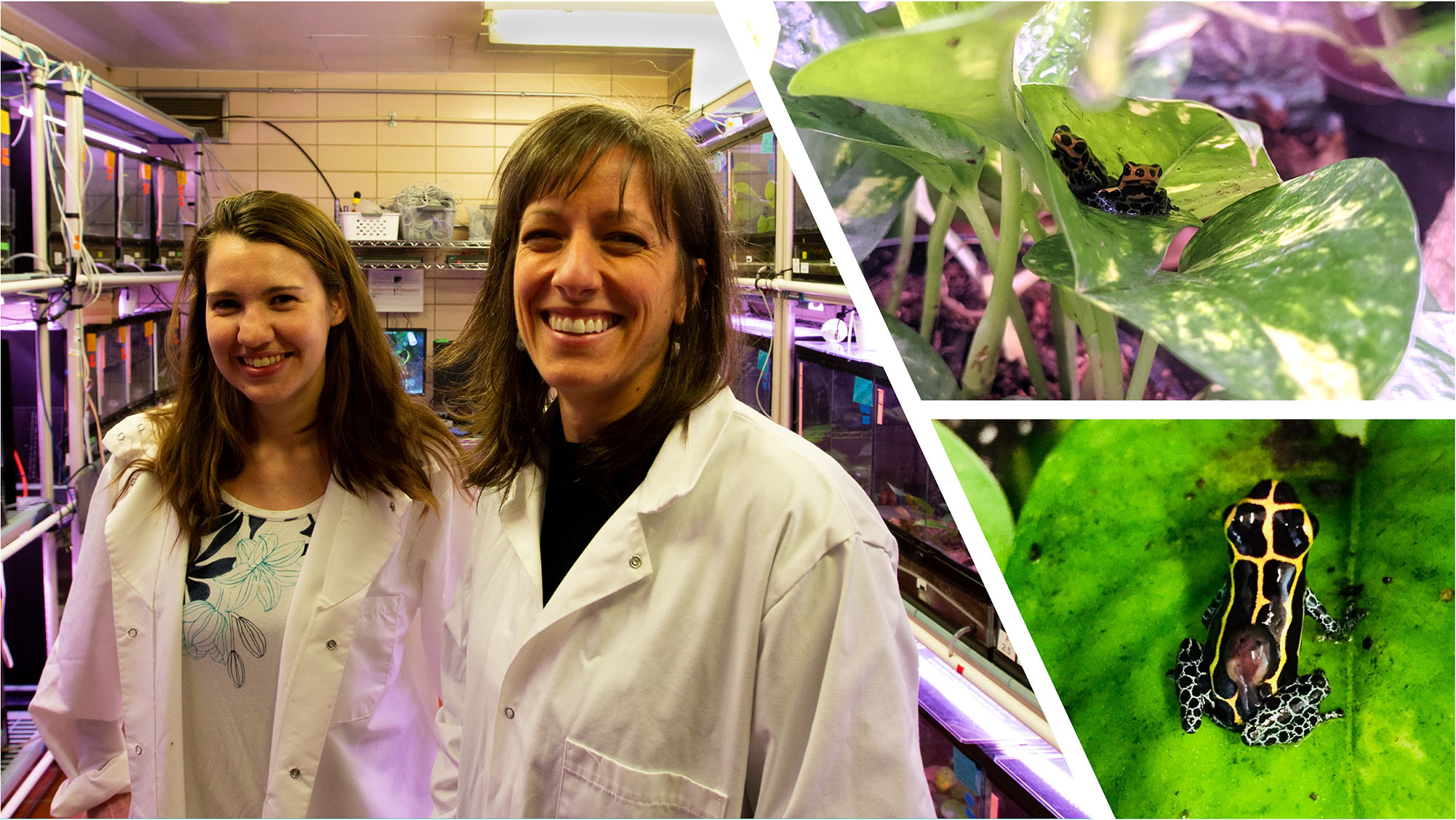By: Shelby Lawson
Many animals produce sounds to communicate with others, often for the purpose of attracting mates, or warning others of nearby predators. Sometimes calls evolve for new and unique purposes, such as the egg-feeding calls of Ranitomeya imitator, otherwise known as the mimic poison frog. While the behaviors surrounding this call have been documented in observations by both natural historians and hobbyist pet owners, the call itself had not been previously characterized. In a new study published in PNAS, Eva Fischer (GNDP), an assistant professor of evolution, ecology, and behavior at the University of Illinois Urbana-Champaign, first-author Jen Moss, a postdoctoral researcher in Fischer’s lab, and James Tumulty, a visiting assistant professor at the College of William & Mary, characterized the acoustic properties of the egg-feeding call in comparison to other well-known male call types for advertisement and courtship.

Males and females of this species watch over their eggs until they hatch, after which males carry the tadpoles on their backs and eventually deposit them into small pools of water. The male will then call to the female, signaling her to feed the tadpole an unfertilized egg, called a trophic egg.
“The tadpoles are deposited in very small pools of water, often within the leaves of plants,” said Moss. “That’s a strategy for them to avoid competition with other tadpoles and avoid predation. But because these pools are teeny tiny, they don't contain a lot of food, which is why egg-feeding by the female is really important.”
The researchers wanted to quantitatively measure acoustic properties of the egg-feeding calls to determine whether they are actually distinct from male calls used for advertising or for courting females. To study this, the team housed frogs in pairs in tanks within the lab and set up microphones and cameras to capture the calls and behaviors of the parents. They recorded advertisement and courtship calls, as well as calls that the males produced in conjunction with egg-feeding by the females, which were labeled as egg-feeding calls. The researchers then characterized and compared the acoustic properties of all the calls, including frequency, bandwidth, and rate of pulses within the spectrum of the calls.
Through their analyses, the researchers found that egg-feeding calls share some acoustic properties with courtship and advertisement calls. Both egg-feeding calls and courtship calls were lower in frequency and volume, which the researchers think is because both are used in short-ranged communication. But egg-feeding calls also surprisingly shared some properties with advertisement calls, with the main being that both calls are of longer length compared to courtship calls. The researchers say that a longer call could be important for enhancing the call’s motivational effects — in other words, the longer call could be better at stimulating the female to egg-feed. These findings suggest that egg-feeding calls evolved by co-opting elements of the ancestral call types for advertisement and courtship.
“Capitalizing on various elements from calls already used in the context of a mate attraction and mate communication makes sense, since females are already well attuned to respond,” explained Moss. “But there is also a selective pressure to modify these co-opted signals to be somewhat unique. When females hear these calls, they need to have enough information to know that they’re meant to feed eggs to the tadpoles, as opposed to the courtship context where females are meant to lay eggs that instead develop into tadpoles.”
“When we think about how language works, sometimes we come up with an entirely new word, but sometimes we come up with a word by recombining other words and using sounds we already have that together give new meaning,” said Fischer. “For example, the words ‘short’ and ‘stop’ mean very separate things alone, but if you combine them to make the word ‘shortstop’, it’s a separate and new thing. So, you can make something new by recombining things you already have, which is what the frogs have done.”
The team also ran a principal component analysis on the calls, which grouped the calls into clusters based on multiple acoustic properties at once. They found that while courtship and advertisement calls had high classification success, the egg-feeding calls clustered more loosely, and overlapped with both of the other call types. According to the researchers, this overlap in acoustic properties with other call types begs the question of how females are consistently able to tell the egg-feeding calls apart. They believe that multimodal signaling, or the use of signals across multiple senses (i.e. hearing, sight, touch), is likely involved.
“There's a lot of overlap between the call types and their properties, so clearly, it's not the only thing that females are using to direct their behavior,” said Moss. “We know that that males physically lead females to pools and that tadpoles beg to be fed, so there's probably visual signals involved as well. We don't know very much about whether chemosensory or olfactory communication is involved during this behavior either. So, vocal communication is clearly an important part of the story, but it’s not the full story.”
Moss, along with undergraduate Molly Podraza, are currently exploring use of multimodal signaling by the frogs in coordinating parental care. Fischer explained that studying communication by the signaler, in this case the male frog, is important, but that it’s also important to study how the receiver, the female in this case, perceives the signal, which can change depending on context.
“Human hearing changes when you become a parent, on the level of the sensory hair cells inside your ear, such that you can identify your baby’s cry over another,” explained Fischer. “And so, another side of this that we haven't explored is whether the females’ perception of the calls also change when they have tadpoles or eggs.”
The team says one of the biggest unanswered questions is why the males need to signal for the females to feed the tadpoles in the first place. When the male is removed from the tank, the female will often still carry and feed the tadpoles in his absence. But this doesn’t always happen, and previous work by Tumulty showed that male signaling does have a significant effect on tadpole growth rate. The researchers are currently examining which factors influence if and when females take over parental care in the absence of their male in hopes of answering this question.
This research was funded by the NSF and University of Illinois, and can be found at https://doi.org/10.1073/pnas.2218956120.
By: Shelby Lawson
Photos By: Fischer Lab



